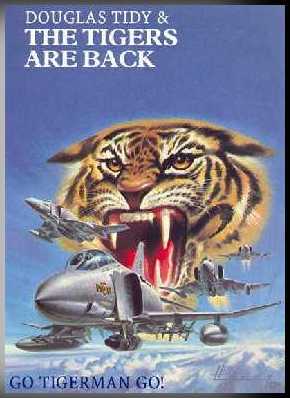

This classic of the first
famous
Tigers has been out of print for 25 years.'The publishers having
ceased business. The only copies available are with the author who will
sign these on request. The author, Squadron Leader Doug Tidy MA
RAF (ret)
served with the Squadron in WW2 with five
Commanding
Officers. Till September of 2000, the squadron, flew Hawks from RAF Valley, on the Isle of Anglesey, off the coast of Wales. Air Vice-Marshal 'Boz' Robinson, who flew
with the
Squadron, and is the president of the Squadron
Association, has
written a foreword to the new editiion. Good luck
Tigers
wherever you may be. From Mannock to Malan to
Mason - it's
all here under the Squadron motto
"I Fear No
Man".


| 
|
|
Spitfire
This new painting by Michael Short shows E.A.W. (Ted) Smith (author of 'Spitfire Diary', who flew Meteors with 74 Squadron) flying a Mk XVI Spitfire of 127 Squadron, attacking a flak barge, and hitting a German vehicle, on the Zuider Causeway in Holland on 16 Apr 1945. His No 2, Alan Willis, got the barge which was firing at Ted.
 Spitfire1.jpg |


 |
This British Military History site owned by
Doug Tidy.
Want to Join the British Military History ring? |
 |
|
[
Previous 5 Sites
|
Skip Previous
|
Previous
|
Next
|
Skip Next
|
Next 5 Sites
|
Random Site
|
List Sites
]
|
||
|
|
This Tiger Squadron Webring site is owned by Doug Tidy [Skip Prev [Prev [Next [Skip Next [Next 5 [Random [List The Tiger Squadron Webring made possible by the Webring. |
 |
No 74 Squadron Royal Air Force has an unbroken
link with
South Africans over the past 80 years.
Lieutenants Kiddie,
Savage, Howe, Clarke, and Van Ryneveld served
with the
Squadron in 1918, and Van Ryneveld's brother
(later Sir
Pierre Van Ryneveld) was commander of XI wing in
which the
Squadron served.
In WW2 South African 'Sailor' Malan commanded the
Squadron,
and Bob Human, 'Tookie' Tooke, and Harries
followed. Once
again there was a Commanding Officer who was a
South African
when John Howe took over the Lightnings in 1954.
Jacques
Kleynhans, 'Lofty' Lance, and Rich Rhodes
followed. Examples
of the 3 types of aircraft flown in WW1 and WW2
are in the
Museum of Military History at Zoo Lake in
Johannesburg
together with other artifacts, including the
instrument
panel of a German Heinkel aircraft shot down by
'Sailor' and
his medals and decorations. Today the Squadron is
responsible for fast-jet pilot training at RAF
Valley, on
the Isle of Anglesey. off North Wales. Doug Tidy served
both in 74
Squadron and in the South African Air Force so has
a great
interest in both.
Home | Airshows | The Hangar | Nostalgia | f4's F4s | Wattisham Chronicles | Links |
Not for the first time, but quite probably the last, on 22 September 2000 74(F) Squadron officially disbanded. Victim of 'rationalisation' in the RAF, three reserve squadrons at Valley was deemed too inefficient, so one had to go, 74 drawing the short straw. In a low-key ceremony outside its hangar at a windswept Valley, the standard was paraded for a final time in front of Air Vice Marshal Robinson, who broke the news that 74 definitely wouldn't be re-appearing as a Eurofighter squadron in the foreseeable future. Speculation had thought that it would, possibly as the Operating Conversion Unit, but it seems a decision has been made and 74 doesn't feature in the RAF of the future. It brings to an end a long tradition, with its finest hour being that with many other fighter squadrons over the skies of southern England in 1940. Formed at Northolt on 1 July 1917, the squadron saw action in France the following year with SE5as. One of the first flight commanders was Captain Mick Mannock, by then already a legendary fighter ace. Thirty-six victories were claimed by Mannock in the first three months of his command, and by July he had recorded a total of fifty-eight, one more than contemporary James McCudden of 56 Squadron. Following this success Mannock was promoted to Major and given command of 85 Squadron. Also with 74 at this time was Ira Jones, who went on to claim thirty-seven victories by the end of the war.
Defensive patrols were made during the early war months and cover provided for the evacuation of troops from Dunkirk. During this time the unfortunate 'Battle of Barking Creek' occurred, described elsewhere on this site in an article on 56 Squadron. The Battle of Britain brought extensive action; based at Hornchurch and its satellite station at Rochford (now Southend Airport), the squadron was in the thick of the battle, protecting the skies over east London. One of the celebrated pilots of the battle, Flt Lt 'Sailor' Malan DFC flew with the squadron and during July tangled with the German air ace Werner Molders - 74's Spitfires chased the Me109s and claimed three destroyed. Malan, a South African by birth, was a born leader of men and had claimed twenty victories by the end of 1940. Awarded the DSO, DFC and bar, he added another twelve victories before retiring from operational flying a couple of years later. Ending the war as Group Captain, he returned to South Africa as a farmer, sadly succumbing to Parkinson's Disease in 1963.
Much of the squadron's life was based overseas and this trend was continued with deployment to the Middle East in 1942, operating from Egypt with Hurricanes. For a brief spell in July and August 74 Was without any aircraft, the ground crews helping with the maintenance of Liberator bombers at Ramat David in Palestine. Conversion back to Spitfires happened in September 1943 while in Cyprus and the squadron remained in theatre until April 1944 when it returned to North Weald to prepare for Operation Overlord. Fighter sweeps followed the D-Day landings, supporting the Army as it swept across France towards Berlin, finally ending with the push through Germany in April 1945. Ironically one of the few squadrons to escape disbandment after the war, 74 converted to the Meteor F3 in 1945 at Colerne, forming the first all-jet fighter wing in the RAF with 504 Squadron. A move back to Norfolk in August 1946 provided a new home at Horsham St Faith, now Norwich Airport. Meteor 8s followed in 1951, the squadron providing one half of the day fighter establishment with 245 Squadron, 23 Squadron being the dedicated night fighter unit with the venerable Mosquito NF36. March 1957 brought an upgrade to the Hunter F4, short-lived as F6s followed six months later. A move back to Coltishall occurred in 1960, Horsham being disposed of by the RAF due to the rapid encroachment of the city around it.
Scotland beckoned with a move north to Leuchars in February 1964, F3s equipping the squadron in the April. XP700 was the first to arrive, but tragedy struck on 28 August when Flt Lt Owen was killed while practising for the annual Battle of Britain Day airshow. This overshadowed 74's stay at Leuchars which lasted three years, when after converting to the longer range F6 it moved to Tengah, Singapore as part of the Far East Air Force under the banner of 'Exercise Hydraulic'. Seventeen (!) Victor tankers were required for the journey across Cyprus and the Persian Gulf, but even so the unit's T5 had to be left behind as it would have put an unacceptable burden on the tankers. Another, XV329, was taken out by ship! As the only air defence squadron in the Far East, 74 were kept very busy with practice scrambles and exercises with other military units. Detachments to Australia were common, again involving support from the Marham Victors, but in 1971 the British Forces in the Far East were withdrawn and 74 was disbanded for the second time on 1 September, its Lightnings re-equipping 56 Squadron at Akrotiri.
Rundown of the Phantom fleet in the early nineties provided a surplus of FGR2 airframes, so to standardise the fleet the 'Js were retired at the start of 1991 in favour of the Spey powered variant. Retirement for the Phantom followed in October 1992, 74 Squadron being the last to operate the type, also having one of the shortest operating careers at eight years.
All courses finished on 22 September, and the instructors will form part of an enlarged 19(R) Squadron, the overall level of training relatively unaffected - the only savings will be administrative. Strength of feeling could be witnessed at the final parade, which ended with the following, led by the acting Commanding Officer, Flt Lt 'Bertie' Archer: "Tiger! Tiger! Tiger! What noise do tigers make?"
"How do we feel about joining 19 Squadron?" All heads hung low. "What noise do dolphins make?" You can imagine the rest... Some may say "It's just a number". But, it's tradition, history, pride and aspiration. It seems astonishing that the RAF will not have its founding member present at future Tiger Meets, for they are and have been a cornerstone of NATO co-operation over the last forty years ago. Time has come to review squadron allocations in the modern-day RAF; maybe it should adopt the French system of smaller squadrons under the administration umbrella of a wing. For if the air force cannot value its past, it will disappear into the ether of a multi-force command. As usual, the beancounters know the cost of everything, but the value of nothing.
|